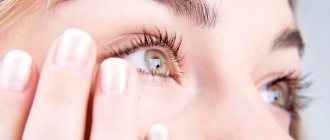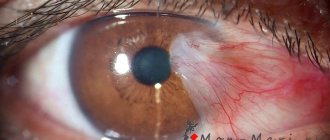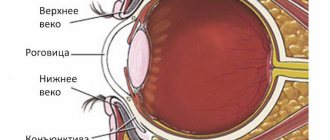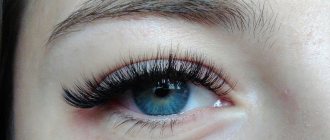What does it look like in a child?
In newborn children, this can be explained by the imperfection of the brain, which is still at the beginning of extrauterine development, and cannot fully control the muscles responsible for eye motility.
There are only seven such muscles, and the child will learn to control them, fix his gaze on an object and follow its movement, only after reaching 1 month. Only a qualified neurologist can ask the question why a child rolls his eyes. The doctor may order an ultrasound examination of the head to rule out any pathologies. Although most often the reason that a child rolls his eyes upward is low tone of the head muscles, including the eye muscles. If the doctor has made such a diagnosis, regular physiotherapy and massage will restore normal coordination and stabilize the muscle tone of the eyes.
It is useful if the baby performs exercises that are based on alternately moving the eyeballs down, up and to the sides. You can hang rotating rattles and bright toys above the crib, then the baby will very soon learn to control the movement of his eyes. After a massage and a set of therapeutic exercises in the clinic and at home, the problem will disappear.
Sometimes the doctor may give the child Graefe's symptom. This pathology of the eye muscles and poorly developed nervous system in children usually goes away on its own with age. Swimming in the pool, prescribed by a doctor, will help. All the deviations described above are explained by the immaturity of the child’s brain and require not so much treatment as simply observation by a specialist.
In rare cases, the problem may be more serious if the child rolls his eyes when falling asleep. He may have increased intracranial pressure. The most accessible method of diagnosing this disease is to have the fundus checked by an ophthalmologist.
Eye rolling, in most cases, occurs in infants when falling asleep. This looks like the iris disappearing under the upper eyelid, leaving only the white sclera visible. The eyes are half-closed at this time, but the pupil is not visible, only a white stripe.
Experienced mothers understand that when the pupil begins to creep upward, the child is ready to fall asleep and begins to doze. Although it often looks like the baby is grimacing and smiling. Sometimes the eyelids remain slightly closed during sleep, leaving only the whites visible. Some parents get scared and think that the baby is ill, as it looks like rolling his eyes when he loses consciousness.
How to treat?
If a newborn baby rolls his eyes, throws his head back and constantly cries, then it is necessary to carry out treatment after identifying the source of the problem. When the disorder is provoked by a neuroinfection, medications of various effects are prescribed. Sometimes pathology manifests itself against the background of excessive intake of drugs or toxic substances, in which case such treatment must be canceled. When the baby rolls his eyes in the first days of life, then in order to normalize visual function and improve the functioning of the visual organs, it is necessary to regularly work with him, using bright toys and objects. With frequent training, the child quickly learns to focus his vision and control his eye muscles, due to which the rolling goes away.
No less important for pathology is special gymnastics, which is prescribed by a doctor to older patients. It includes the following classes:
Gymnastics for the eyes helps strengthen the muscles of the organs and improve the functioning of the visual apparatus.
- frequent blinking;
- rotational movements of the eyeballs clockwise and counterclockwise;
- strong closure of the eyelids and relaxation.
For children who experience eye rolling, a relaxing massage is recommended, as well as activities in the pool. It is possible to cope with the disease through physiotherapeutic procedures. If the problem of rolling the eyeballs is associated with a nervous tic, then it is important to provide the baby with peace and avoid stress and overwork.
First aid for an epileptic attack
When a baby rolls his eyes during an epileptic seizure, parents should remain calm and not panic so that they are able to help the child. The baby should turn his head to the left or right to prevent the tongue from retracting and to facilitate the passage of saliva. Under no circumstances should you open clenched teeth with your fingers or other objects. It often happens that after an attack the child falls asleep, so you should not wake him up. If your eyes roll back as a result of epilepsy, it is recommended to consult a doctor as soon as possible, since with each new seizure the patient’s condition worsens, which negatively affects psychomotor and mental development.
What to do if your baby rolls his eyes?
Comments:
Rating: 20
If a child older than 1 month rolls his eyes, this should alert parents. At first, any baby cannot control the system of muscles that controls the eyes, but if he is more than a month old, he should be able to concentrate his gaze on one object.
Causes of eye rolling symptoms
Loving parents closely monitor any, even small, changes in the baby’s behavior. Many people are frightened when a baby suddenly rolls his eyes, although there is no reason for this.
You need to contact a specialist if:
- the child behaves restlessly, cries, screams, twitches and rolls his eyes;
- The baby is more than 3 months old and the problem does not go away.
The causes of unpleasant symptoms are:
- uneven muscle tone and weakness;
- increased intracranial pressure;
- epilepsy;
- Graefe's symptom.
Return to contents
The human eye is a complex organ with which it sees the world. The eyes are controlled by a group of muscles, and in a newborn this process is still imperfect, and only at the age of more than 1 month does he begin to focus his gaze on bright objects and toys. A premature baby often rolls his eyes.
A newborn baby may roll his eyes when falling asleep, and this behavior of the baby is associated with the peculiarities of his development. At this moment, he is in a borderline state between sleep and wakefulness, so this phenomenon does not pose a health hazard. Gradually this problem will go away on its own.
If this phenomenon does not disappear as the baby grows older, you should immediately consult a doctor for advice.
A baby may roll his eyes downward before going to sleep, which indicates a disorder, Graefe's symptom. This diagnosis is given to children in whom a white stripe of the white of the eye is visible between the eyelid and the iris when the eye moves downwards.
A newborn baby cannot control eye movement, and parents must distinguish between what is normal and where pathology begins.
Be careful if, in addition to abnormal eye movements, the baby has other symptoms: throwing back the head, squinting, excessive regurgitation, prolonged crying.
After the examination, the neurologist and ophthalmologist will prescribe an examination, a course of special physical therapy, or recommend simply monitoring the child’s further development.
Return to contents
The question of what to do if a baby rolls his eyes worries many parents who fear for the health and proper development of their child. The right decision is to immediately consult a doctor. A specialist must diagnose the disease and prescribe treatment.
If a child is diagnosed with physical muscle weakness, he needs to undergo treatment: a set of exercises, massage, physiotherapeutic procedures. Treatment will help improve the muscle tone of the eye.
It is carried out in a clinic or at home. It is necessary to carry out daily treatment procedures that will help remove unpleasant symptoms.
Gymnastics for the eyes should consist of training the eyeballs: you need to rotate them, look in different directions, up or down. Exercising in the pool and massage help a lot.
The little man needs to be trained with the help of toys and bright objects. They will help your baby adjust and focus his vision. Regular exercises will help improve the functions of the child’s eyes, who will not have vision problems in the future.
The baby begins to explore the world with a rattle, and it is important to choose bright toys that will help improve vision, hearing and concentration skills. After a course of treatment, by 6 months the child’s condition returns to normal.
Parents need to contact specialists in a timely manner so that their child’s health problem does not become chronic, especially since this is a completely curable disorder.
zdorovyeglaza.ru
When to worry and why
You should sound the alarm and, as a result, contact an ophthalmologist or neurologist if:
- the child turned 3 months old, but he did not stop rolling his eyes;
- when falling asleep, his eyeballs go down, not up;
- during periods of wakefulness, the mother also observes how the newborn baby rolls his eyes;
- at such moments he becomes capricious, cries, expressing concern with his entire appearance.
All these symptoms may indicate the presence of serious developmental pathologies in the newborn, namely:
- nervous disorders;
- Gref's symptom - do not confuse it with Gref's syndrome, or a pathological condition of the brain. Gref's sign is the presence of a white stripe above the iris of the baby's eye. It is easiest to notice when the baby rolls his eyes downwards. Be that as it may, there is no need to worry ahead of time. Perhaps this is simply an individual characteristic of the child due to the immaturity of his nervous system, which, under the supervision of a doctor, can go away by 6 months;
- hydrocephalic syndrome. It is manifested by an excess of cerebrospinal fluid in the head, which for some reason has remained there since prenatal development. The disease is confirmed by a comprehensive examination - MRI, tomography, neurosonography and requires immediate treatment, which is very often successful. In its absence, an increase in intracranial pressure and developmental delay may occur. It is noteworthy that the disease is indicated by rolling the eyes downwards, accompanied by throwing the head back and increased excitability;
- epilepsy. If it occurs, the rolling of the eyes is accompanied by convulsions, muscle tone, cessation of breathing during sleep, sharp turns of the head from side to side during sleep;
- dystonia of the eye muscles;
- increased intracranial pressure;
- weak eye muscles.
Pathological causes
Eye rolling is considered a normal physiological process in a newborn, but it can also be a sign of dangerous diseases. It is necessary to study the reasons why a child rolls his eyes in order to react correctly to this phenomenon and, if necessary, consult a doctor.
Immediately after birth, some of the newborn's body systems are not yet fully developed; their final formation occurs during the first year of life. This is also true for the organs of vision. Infants have poorly developed extraocular muscles, a small size of the eyeball, an underdeveloped retina, and a weak neural connection between the optic nerve and the visual nuclei in the brain.
Parents themselves may notice this, since the newborn is not able to focus his gaze on objects. This ability, like the friendly movement of the eyeballs, begins to form by the end of the second month of life. The functionality of a child’s eyes develops gradually in the process of strengthening connections between the organs of vision and the brain.
We suggest you read: Balanoposthitis in a child: causes, symptoms, treatment
The physiological causes of eye rolling are weakness of the eye muscles, which should hold the eyeball in its normal position, as well as poor development of the nerve centers responsible for their control. Since the muscles are controlled by the brain, you will most often see a newborn rolling his eyes when falling asleep, and this control is weakened.
Eye rolling is a normal state of a child in a borderline state of sleep.
Normally, when falling asleep, you can see the following: the baby blinks frequently, rubs his eyes and nose, fiddles with his ears, looks for his mother’s breast, yawns, his head falls back, the child rolls his eyes up. You can also see that when the baby sleeps, his eyelids open slightly and part of the white is visible.
Even in adults, the volitional rolling of the eyes upward leads to the reflexive onset of sleep. This method is sometimes recommended for those who have difficulty falling asleep.
If a newborn baby rolls his eyes, but does not have other unusual symptoms, then this condition is normal, corresponding to the level of development of his nervous system.
However, if the unusual position of the eyeballs in an infant is not associated with sleep and the child is older than three months, then you should pay attention to the possible presence of other symptoms. A condition is considered dangerous when a newborn child rolls his eyes downward, there is nystagmus (involuntary small movements of the eyeballs from side to side), nervous tics (fluttering of the eyelids), convulsions and irregular breathing rhythm.
In neurological disorders, eye rolling is accompanied by nystagmus
Visual impairment in preschool children
- inflammatory or traumatic damage to brain structures such as the pons, labyrinth, cerebellum, cerebellum and pituitary gland;
- poisoning with drugs or toxic substances;
- neuroinfection;
- fever;
- genetic mutations;
- epilepsy or seizure disorder;
- hydrocephalic syndrome;
- increased pressure inside the skull;
- mental development disorder.
Nervous tension can also be expressed in children in the form of small epileptic seizures – absence seizures. In this state, the baby rolls his eyes and seems to “freeze” - all other mental functions stop (movement, humming, any reactions). After the attack ends, the child returns to his normal state. An absence seizure can turn into a grand mal seizure, so you should consult a doctor without waiting for it.
Also, the eyes may take an incorrect position if the child has pain in the eyeball or orbit due to various ophthalmic inflammatory diseases, adenoids, sinusitis, inflammation of the tonsils or otitis media, neuritis of the facial or trigeminal nerve.
The photo shows Graefe's symptom, the iris is directed downwards
An indicative appearance of the eyeball in children with hypertensive-hydrocephalic syndrome takes on pathological rolling. The so-called Graefe symptom or “setting sun” occurs when the eyeball is turned with the iris downward, so that a stripe of white is visible above it. This situation is caused by damage to the brain and the pressure of cerebrospinal fluid accumulated in its ventricles.
However, Graefe's symptom is not an accurate diagnostic sign of hydrocephalic syndrome. The reasons that a child rolls his eyes downward may be illnesses of the pregnant woman, rapid labor, birth trauma, prematurity or postmaturity, as well as hereditary predisposition.
How does it manifest?
An illness caused by an attack of epilepsy is accompanied by additional symptoms, for example, clenching of the jaw. With pathology, the patient’s eyes often roll upward, and sometimes breathing stops for a while. The deviation may affect one visual organ, or the person involuntarily shakes the eyeball in different directions with both eyes. If the disorder is caused by an epileptic seizure, then the following additional symptoms are possible:
- foaming at the mouth;
- throwing the head back;
- short-term lethargy and foggy consciousness;
- strong clenching of teeth;
- convulsions;
- dilated pupils;
- rare breathing;
- involuntary urination;
- occasionally the patient loses consciousness.
Pathological rolling of the eyes in adults with high levels of intracranial pressure is often accompanied by nausea and vomiting. If you do not consult a doctor for help in time, then complete or partial loss of vision is likely, which cannot be corrected. When a newborn involuntarily rolls his eyes, no additional pathological symptoms are noted. At the same time, it is important to monitor the child’s condition, and if other unpleasant symptoms occur or do not go away after a month, you should urgently see a pediatrician.
The child rolls his eyes
Loving and attentive parents always take care of their babies and notice the slightest changes in their behavior. Something pleases them, something amuses them or makes them proud, but it also happens that some features of the child alarm mothers and fathers. One such cause for concern is the behavior when a child rolls his eyes. It’s okay if the baby is not even a month old; at that age, children still do not know how to control the system of muscles that control eye movement. But after 30 days of life in this world, babies should already learn to focus their gaze on one object.
Why does a child roll his eyes?
Only a qualified specialist can answer the question: why does a child roll his eyes, so it is extremely important to consult a doctor in a timely manner for advice. Most often, such children are prescribed an ultrasound examination of the brain and a mandatory visit to a neurologist. If a specialist discovers uneven muscle tone in a child, they usually conduct a course of special physical therapy, which quickly relieves children of this problem. Very rarely, such a symptom indicates increased intracranial pressure or epilepsy, so mothers and fathers should not panic ahead of time.
If a child rolls his eyes up when he falls asleep, then there is no need to worry either. Take this peculiarity of the baby as a fact; many pediatricians consider this state of the baby to be borderline between sleep and reality, meaning that the baby is almost asleep. If a child rolls his eyes downward in his sleep, then this may be a symptom of Gröfe's syndrome. Contact a neurologist for advice to avoid future health problems. But in general, many experts agree that if nothing else in your baby’s behavior worries you, then you don’t need to worry; it will go away as you grow older.
In general, we can conclude that this feature of children’s behavior most often does not pose any danger to their health: a newborn child rolls his eyes only because he does not yet know how to control them, and an older baby either indulges or is comfortable with it at certain moments in life. The main thing to remember is that this will pass! If you have any doubts, you can always contact a neurologist for advice and a full examination.
| Riabal is a popular anti-colic drug for babies. Many parents, having heard about it, give it to their baby themselves. Do not forget about the contraindications and side effects of this drug. In our article we will talk about the indications and rules for using riabal for newborns. | Constipation in a newborn - what to do? The digestive system, like other systems of a newborn baby, is not yet fully established, so malfunctions often occur. One of these problems can be constipation, which causes discomfort to the baby and can have unpleasant consequences. We will tell you how to help a newborn with constipation in our article. |
| Toxic erythema of newborns From the moment a baby is born, his skin, as well as all other organs, goes through the process of adaptation to new conditions. The functioning of its cells improves, and sometimes you may notice redness or the formation of blisters. This phenomenon is called erythema. Physiological and toxic erythema will be discussed in our article. | Breast milk for a runny nose Our grandmothers used breast milk to treat a runny nose. But what does modern medicine say about this method of healing? In this article we will talk about all the possible consequences of this approach and how you can still help your baby fight annoying snot. |
womanadvice.ru
How to learn to roll your eyes until they are white
Some people begin to roll their eyes white during a conversation, especially when they are nervous.
According to psychologists, such an action indicates a person’s disagreement with the words of the interlocutor or that he is making a temporary concession. If a person often rolls his eyes to the whites, then we may be talking about some serious neurological diseases. But there are people who want to consciously learn to roll their eyes so that only the whites are visible.
Is it okay to roll your eyes?
If a person rolls his eyes occasionally, during an overly emotional conversation, then there is nothing wrong with that. But doctors do not recommend doing this often and deliberately. This can lead to overstrain of the eye muscles and damage to blood vessels. As a result, this pampering may result in reddened and swollen eyes.
Although there is an opposite opinion. Some doctors believe that such an action leads to nothing other than making the person look stupid and even scary. The fact is that the human eye is adapted to various movements. True, with natural convergence the eyes do not move so significantly.
In some cases, rolling your eyes will help relieve nausea quickly. Experts explain this by special impulses that enter the brain.
How to roll your eyes white
Anyone can learn to roll their eyes until they are white. This won't take much time. It is recommended to perform such training almost immediately after waking up, in this case you can achieve the desired result faster.
There are many recommendations on this matter on the Internet. You can try different methods and choose what suits you best:
- The eyes roll upward as much as possible, looking at their own eyebrows. Next, you need to pull your cheeks down with your hands so that the upper eyelid covers the iris and pupil well. Training should be carried out frequently, in the end it will be possible to achieve the desired effect without using your hands. You shouldn’t be too zealous, otherwise you can damage your visual organs.
- You can squint a little and look up at the same time.
- You can roll your eyes down to the whites. To do this, try to look at your lower lip, and at the same time pull your eyebrows up with your hands. Constant training will definitely help you achieve the desired result.
- People who practice yoga and meditation advise doing this. Immediately after waking up, without getting out of bed and without opening your eyes, you close your eyeballs, as if looking at a point in the middle of your forehead. If you then slowly open your eyes, only the whites will be visible.
- There is such a technique. They look for a few seconds at a point at a distance of 30 cm from themselves, then move the point on which they concentrate their attention to the distance of an outstretched arm. After 30 seconds, the point is moved approximately 2 meters. After this, the point of concentration is moved up, above the head. In most cases, the eyes roll back.
It is worth considering that when rolling your eyes, noise and vibration often occur in the head. Particularly susceptible people may fall into a trance.
If there are any neurological diseases or mental disorders, then it is better to refuse such experiments.
How to make the whites of your eyes whiter
Many people consider the white whites of the eyes to be an indicator of beauty and health. But in most eyes, the sclera is reddened and has a yellowish-gray tint. First you need to make sure that there are no chronic diseases of the liver, kidneys and metabolism, and only then try to give the ideal whiteness to your eyes.
It is impossible to whiten the visual organs like teeth, but eye drops that constrict blood vessels can improve the situation somewhat:
- Visine;
- Naphthyzin;
- Emoxy optic;
- Irifrin;
- Okumetil.
All these medications quickly eliminate inflammation and irritation. The whites become almost perfectly white, and the red blood vessels disappear. But it is worth considering that such medications can only be used for a short course. All of them are addictive, due to which the effect is greatly reduced.
You can get rid of redness and yellowness using a number of folk recipes:
- Tea brewing helps a lot. It contains tannins that have a beneficial effect on the visual organs.
- You can brew chamomile and lemon balm. This decoction has a strong anti-inflammatory and calming effect.
- Apply slices of fresh cucumber to your eyelids for 20 minutes. You can grate the vegetable on a fine grater, add a little water and pour the resulting mass into ice cube trays. In the morning, rub the area around the eye sockets with ice cubes.
- Freeze the chamomile decoction and wipe the eyelids with cubes several times a day.
It’s definitely worth reconsidering your lifestyle. In some cases, a good rest is enough for the condition to return to normal.
You should avoid using medicinal herbs if you are allergic to plants.
Diseases that cause eye rolling
Rolling your eyeballs up or down can be a sign of serious illness. This symptom may indicate the following ailments:
- Epilepsy. The patient does not necessarily experience convulsions or foam at the mouth. With a mild course, the disease can manifest itself in this way;
- Diseases of the nervous system and mental disorders;
- Brain tumors;
- Hydrocephalus;
- High intracranial pressure.
Rolled eyeballs can be used to impress a girl or scare someone. Some young people use this trick during unusual photo shoots. But before you resort to rolling up, you need to think carefully about whether this is really necessary?
Source: https://oculistic.ru/info/kak-zakatyvat-glaza-do-belkov
Until what age is it normal to fall asleep?
Eye movements are carried out by a whole group of muscles, which, like all other muscles in the baby’s body, are in their rudimentary form at birth. The movements of the arms and legs are chaotic, and the newborn is not yet able to regulate them. The eyes are a paired organ; controlling their movement is even more complex. Therefore, in newborns, temporary strabismus is often noticeable, which gradually goes away with strengthening of the muscles.
When a baby falls asleep, he completely loses control over his fragile muscles. Up to 90% of babies under the age of one month roll their eyes. The nervous system gradually improves, muscles become stronger, the child begins to focus his gaze and follows objects.
We invite you to familiarize yourself with: Symptoms and treatment regimen for allergic dermatitis in children under one year of age and older
Pediatricians believe that in infants the upward movement of the pupils when falling asleep during the first 2-3 months is within normal limits.
Features of a baby
Normal indicators for a newborn
Eye rolling in newly born children is normal, since their visual muscles have not yet strengthened. Often the baby rolls up his pupils while lying on his back in the first days of life or several months after birth. This condition does not indicate pathology if it is not accompanied by any other symptoms and does not cause concern. The reason why a baby turns his eyes up or down is due to weak muscles of the visual organs. The baby also has difficulty focusing his vision on a specific object, but as it develops, the problems go away on their own. Often a newborn rolls his eyes when he falls asleep, which should not cause anxiety in parents. In this case, the norm is the location of the pupils at the top, and not at the bottom.
Pathological causes in children under one year of age
When an infant involuntarily lowers his eyes down, this may indicate a serious disorder that requires urgent treatment. If a baby, who is a month or more old, has strong squirrel rolls in one direction or the other, then the following disease can affect this condition:
- uneven muscle tone;
- increased pressure inside the skull;
- epilepsy attack;
- Graefe syndrome or “setting sun”, against the background of which the baby rolls his eyes when he falls asleep or during sleep.
Advice and recommendations from doctors
Eye rolling at an early age is not an abnormal behavior, but if it does not stop after 2-3 months, it is time for parents to worry. Deviations in the state of health and alarming signs of illness can be judged by a number of symptoms and characteristics of the infant’s condition.
A newborn can communicate all worries, pains and inconveniences only by screaming. Frequent crying, reaching the point of hysterics, when the baby twitches and cannot calm down for a long time, indicates serious problems. Another alarming sign is poor sleep, inability to relax or fall asleep soundly.
Anxiety should be caused by erratic movements of the pupils, their movement in different directions, not only upwards, when falling asleep. Unnatural twitching and uncoordinated eye movements should be reported to your doctor.
A tilted head in a baby may be a sign of certain diseases.
Developmental delay
Developmental delays - insufficient weight gain, inconsistency with other age norms - should be a cause for concern.
Jaw trembling
Jaw twitching may be a sign of the development of neurological or endocrine disorders in an infant.
Strabismus
Strabismus becomes noticeable in the first months of life and requires timely treatment.
A disproportionately growing head may be a physiological feature and gradually straighten out or require serious treatment for hydrocephalus.
Vomiting, nausea
Frequent regurgitation and vomiting are a sign of an underdeveloped digestive system in a newborn. Sometimes they indicate the development of dangerous diseases.
If the baby does not eat well, regularly does not meet age-appropriate feeding standards, or the sucking reflex is poorly developed, you should consult a pediatrician.
The baby must gradually learn to coordinate his movements - pull the arms, follow the object with his eyes, turn his head towards the sound. If coordination is impaired, nervous system disorders may be diagnosed.
A dangerous sign is an increase in temperature. This is a reason to urgently call a doctor without trying to knock it down yourself.
The main task of parents is to carefully monitor the condition of the newborn and pay attention to additional symptoms other than eye rolling. If the baby is cheerful and gaining weight well, there is no reason to worry. You should tell your doctor about your concerns during visits and medical examinations.
Parents, together with doctors, must determine in time when eye rolling is not a physiological feature of young infants, but indicates the development of pathologies. An alarming sign is that the baby is already more than 3 months old, but the rolling of the eyes does not decrease; it occurs not only before falling asleep, but also while awake.
Increased intracranial pressure in an infant is characterized by many signs, including rolling and protruding eyes. Hypertension can be suspected by a disproportionate increase in head size and severe anxiety in the infant, as he suffers from headaches.
ENT disease
Severe diseases of the nasopharynx (also otitis media) can negatively affect the eye muscles and provoke their weakening. As a result, the rolling of the pupils of an infant may last longer than physiological norms.
Graefe syndrome
Eye rolling may be a partial or isolated manifestation of Graefe syndrome, caused by excess cerebrospinal fluid in the brain. In this case, rolling up is called Graefe's symptom.
It is characterized by the movement of the eyeballs down to the lower eyelid, slight mobility of dilated pupils. In this case, the baby throws his head back. Usually the muscle condition returns to normal by 6 months.
Eye rolling may be a warning sign of the onset of epilepsy. In this case, the child suffers from convulsive movements and has increased muscle tone. During sleep, short-term pauses in breathing may occur, and the baby turns his head sharply and frequently.
Muscular dystonia
Increased or decreased tone of the eye muscles, causing the pupils to roll back, may be a sign of muscular dystonia. This is one of the syndromes of central nervous system damage.
We suggest you read: A child swallowed a battery: what to do?
Some advice from doctors for young parents:
- In the vast majority of cases, eye rolling is simply a physiological feature of infant development. Don't worry ahead of time.
- Do not skip preventive examinations by specialists - they will notice problems in time.
- Pay more attention to your baby. Talk to him while moving around the room. Let him watch his mother with his eyes - this is an effective training of the eye muscles.
- Follow the recommendations - do gymnastics for the eye muscles, massage, if prescribed.
You should not come up with your own methods of treating infants or use traditional methods without the recommendations of a pediatrician. Parents should know that a baby may roll his eyes for completely harmless reasons - due to simple underdevelopment of muscles. But it is necessary to monitor the baby’s condition and notice problems in time to help the child strengthen his muscles and stimulate his immune system. Early detection of pathologies of the eyes and nervous system will help the baby quickly cope with the disease.
Symptoms that require immediate medical attention
There are a number of symptoms that require you to immediately make an appointment with a neurologist:
Nothing indicates the importance of parental responsibility towards children and their duty to provide them with a proper Islamic education than the teachings of every family to remember the words of the Prophet: “Teach your children to pray when they are seven years old, and if they do not do so when they are ten years, they are connected.”
A family that knows this hadith but does not teach their children to pray when they reach the age of seven or is embarrassed to even hit them if they do not do so when they reach ten years of age is a family that has failed to fulfill its duty and has neglected its children. These parents are sinners who will answer to Allah for their failure and neglect. The parental home is the first environment in which these little people grow up: it is the environment in which their inclinations, gestures and personalities are formed.
- The child began to eat very poorly, but often spits up.
- The baby throws his head back, lying on his side.
- The baby doesn't move well.
- One of the child’s limbs “does not obey” him, but the second one works normally.
The first weeks after discharge from the hospital are filled with both delight and anxiety. Young parents carefully monitor every change in the baby’s behavior. One of the alarming moments is when a child rolls his eyes. Doctors have different opinions, and parents cannot understand why the child rolls his eyes and what to do about it.
First of all, you need to understand whether this is the beginning of a disease or a variant of the norm. To do this, you should monitor your baby throughout the day. Analyze how often he rolls his eyes, because this could be an element of a kind of game or a new skill for the baby. Often in this way the baby attracts the attention of the mother.
In the first months after birth, the baby explores the capabilities and characteristics of his body. Muscles cannot be completely controlled. This is especially true for the eye muscles. It is difficult for him to concentrate on any object, so if a child is 1 month old and rolls his eyes, then this is a variant of the norm. There are cases when the process lasts for three months. However, if this continues for a long period of time, then parents need to be wary and seek help from their pediatrician. He, in turn, will refer you for consultation to a neurologist and ophthalmologist.
Another common complaint among parents is rolling their eyes while falling asleep. So why does a newborn roll his eyes when falling asleep? In fact, this feature is inherent in every person. All people roll their eyes upward when falling asleep. If a baby rolls his eyes before going to bed, this indicates that he is in a state of drowsiness and is practically already asleep. Accordingly, in this case there is no need to worry.
How to roll your eyes white
» Articles » How to roll your eyes until they are white
Some people begin to roll their eyes white during a conversation, especially when they are nervous. According to psychologists, such an action indicates a person’s disagreement with the words of the interlocutor or that he is making a temporary concession.
If a person often rolls his eyes to the whites, then we may be talking about some serious neurological diseases. But there are people who want to consciously learn to roll their eyes so that only the whites are visible.
How to roll your eyes
Update date: 04/29/2019
Mostly people start rolling their eyes during a conversation.
This is a response that often expresses dissatisfaction with the words of the interlocutor.
Often this becomes a habit and a person begins to show negative emotions. Sometimes people do this involuntarily.
Why do they roll their eyes?
According to statistics, girls begin to roll their eyes white as early as adolescence. It is very rare to observe this in males. Women use these habits to maintain balance during conversations. For example, when the interlocutor says words that evoke strong emotions. Sometimes this happens in the form of a reaction to teachings. Teenagers especially don't like this.
Rolling your eyes can also indicate aggression, a desire to remain calm and not show your emotions. Parents are advised to pay attention to such manifestations. As an adult, it is difficult to get rid of them. For some, this habit may have persisted since childhood.
Is it safe for eyes and vision?
Some people specifically learn to do this trick. If you do this periodically, it will not affect your eye health. Doctors do not recommend doing this often or on purpose. Such procedures can cause overstrain of the eye muscles and damage to blood vessels. This can cause redness of the mucous membrane. But in most cases, such manifestations are not dangerous.
Prevention
Careful and constant observation is one of the most accessible and informative ways to determine whether a newborn's eye rolling is pathological. It is necessary to observe the baby’s behavioral habits, note how he behaves before falling asleep, whether he rolls his eyes at other times of the day, and whether there are other neurological symptoms. If the baby is premature, then in the first time after birth he will always have his eyes rolled up until he reaches the desired level of development.
If alarming symptoms appear, you should visit a pediatric neurologist, ophthalmologist, and otolaryngologist.
What do scientists say about this?
But when it comes to why exactly we do this, questions arise. Scientists have done a lot of research to understand the essence of this pun. We tend to roll our eyes in disapproval or contempt, perhaps as a way to protect our gaze from something unpleasant. The effect is most common in adolescents, especially girls.
First woman on the moon: Nat Geo will chronicle the Artemis program
To nourish and moisturize my hair, I make my own serum with rosemary: a simple recipe
The Japanese said what they found in the container that delivered the asteroid samples
According to the authors of a 2012 article on social aggression in teenage girls, this facial expression is quite common in both young girls and adult women. It can express both aggression and discontent. On the other hand, boys are more likely to be physically aggressive. Don't despair, parents of teenage girls. According to the New York Times, when daughters roll their eyes at their parents, it's just a way to express objection without resorting to complete disobedience.
When not to worry
If the baby does not cry and does not experience anxiety, he does not vomit or have a high temperature, then in some situations such unnatural, at first glance, behavior should not cause concern:
- During sleep, children sometimes throw their heads back. Most often, babies under 4 months behave this way. In this case, you only need to occasionally change the baby’s position so that his neck muscles do not become stiff.
- Very often, parents put a huge number of different toys in their baby’s crib. Perhaps one of them ended up behind the baby's head. Since he does not yet know how to hold his head up, the child rolls his eyes upward, trying to look back. Place all the toys in front of your baby so that he can easily reach them.
Intermittent, persistent abdominal pain that usually gets worse after eating can be caused by parasites. The stools stink, the child is gaining weight. You will need a caudal examination and your doctor will prescribe treatment. Sometimes my stomach hurts because the baby eats too much. The relief will bring drops of bloodworms.
Children from one month to one year
Abdominal pain may indicate intolerance to a prescribed medication, especially an antibiotic. You should talk to your doctor - he may change the medicine to another one. Constant abdominal pain, such as before going to daycare or before leaving a parent's home, can be a sign of stress. You need to talk to your child about what is happening.
- If the child only throws his head back, and this happens while he whines, then this is also not a terrible sign. Most likely, this is just a minor nervous disorder that will pass soon.
- If the baby throws his head back and rolls his eyes, this may be an attempt to sit up or roll over onto his stomach.
The child rolls his eyes - what does it look like?
Parents often turn to the pediatrician with a complaint - the infant rolls his eyes and opens them in his sleep. A newborn baby’s eyelids indeed often open during rest, with the pupil moving upward and only the whites remaining visible. The eyes can be only slightly open, or they can open completely.
Sometimes an older child rolls his eyes upward before falling asleep or while awake. You cannot ignore such behavior or scold him for self-indulgence. Perhaps something is bothering the baby. Try to monitor the child’s condition - there may be other warning signs.
Treatment
If treatment is required, then for eye rolling of neurological origin, nootropic drugs, drugs that improve blood supply to the brain, and sedatives are usually prescribed. Complex neurological injuries may require endoscopic surgery or neurosurgical intervention.
The baby is examined by a neurologist and ophthalmologist. Based on the research results, treatment tactics for identified neurological or ophthalmological diseases are selected.
Therapeutic measures
If the baby is growing and the eye rolling continues, the doctor may prescribe therapeutic measures to strengthen the muscles. Diagnostic tests are usually performed when several warning signs are present or when the child is more than 3 months old. The eye muscles are strengthened without drugs using exercises and physical therapy.
Gymnastics for the eyes
The simplest exercises for the eye muscles are carried out for infants in the form of a game. The baby is taught to focus his gaze while following a toy. To do this, choose a bright rattle and slowly move it in front of your eyes, drawing attention to it. It is important that the baby is healthy, well-fed and in a good mood at this time.
A mobile phone that is great for independent training attracts kids with a variety of bright objects and teaches them to independently choose an object to observe.
Massage has a general strengthening effect and increases muscle tone in the baby. It is important to find a good specialist who knows how to work with infants. A special eye massage strengthens the eye muscles and improves coordinated joint movements of the eyeballs.
Self-massage will not give the desired result. Parents can invite a massage therapist to their home or visit a clinic. If there are indications, other physiotherapy procedures are prescribed - therapeutic baths with soothing phytocomplexes, physical therapy exercises for muscle development, reflexology.










